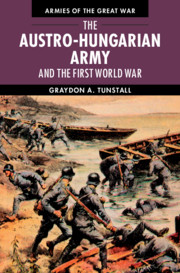Book contents
- The Austro-Hungarian Army and the First World War
- Armies of the Great War
- The Austro-Hungarian Army and the First World War
- Copyright page
- Dedication
- Contents
- Figures
- Maps
- Acknowledgments
- Introduction
- 1 The Austro-Hungarian Army
- 2 July 1914 Crisis
- 3 Galicia, August–September 1914
- 4 Serbian Campaigns 1914
- 5 Galicia, October–December 1914
- 6 1915
- 7 1916
- 8 1917
- 9 1918
- 10 November 1918 and Results
- Conclusion
- Notes
- Bibliography
- Index
6 - 1915
Published online by Cambridge University Press: 10 November 2021
- The Austro-Hungarian Army and the First World War
- Armies of the Great War
- The Austro-Hungarian Army and the First World War
- Copyright page
- Dedication
- Contents
- Figures
- Maps
- Acknowledgments
- Introduction
- 1 The Austro-Hungarian Army
- 2 July 1914 Crisis
- 3 Galicia, August–September 1914
- 4 Serbian Campaigns 1914
- 5 Galicia, October–December 1914
- 6 1915
- 7 1916
- 8 1917
- 9 1918
- 10 November 1918 and Results
- Conclusion
- Notes
- Bibliography
- Index
Summary
In Chapter 6, the disastrous Carpathian winter war battle in early 1915 is described in detail including its significance and detailed description of some of the worst battlefield conditions ever witnessed in the history of warfare. Many soldiers succumbed to the “White Death,” or freezing to death. The point is made that the battle should never have been fought. The drawn-out negotiations with Italy and then the first four Isonzo River battles are presented. The great Central Power victory of Gorlice–Tarnow is described, followed by the disastrous Habsburg Rovno campaign. Finally, the chapter describes the German-commanded Serbian campaign and its repercussions for the Central Powers.
- Type
- Chapter
- Information
- The Austro-Hungarian Army and the First World War , pp. 185 - 242Publisher: Cambridge University PressPrint publication year: 2021

